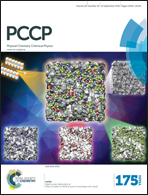Tribotronic control of friction in oil-based lubricants with ionic liquid additives†
Abstract
Atomic force microscopy (AFM) reveals that tribotronic control of friction using an external potential applied to a gold surface is possible for ionic liquid (IL) concentrations as low as 5 mol% in hexadecane. The IL used is trihexyl(tetradecyl)phosphonium bis(2,4,4-trimethylpentyl)phosphinate, in which both the cation and anion have surfactant-like structures, and is miscible with hexadecane in all proportions. For IL concentrations less than 5 mol% friction does not vary with applied potential, but for 5 mol% and above changing the potential changes the composition of the IL boundary layer from cation-enriched (negative potentials) to anion-enriched (positive potentials). As the lubricities of the cation-rich and anion-rich boundary layers differ, this enables active control of friction in oil-based lubricants.


 Please wait while we load your content...
Please wait while we load your content...